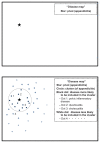Pivot and cluster strategy: a preventive measure against diagnostic errors
- PMID: 23204855
- PMCID: PMC3508570
- DOI: 10.2147/IJGM.S38805
Pivot and cluster strategy: a preventive measure against diagnostic errors
Abstract
Diagnostic errors constitute a substantial portion of preventable medical errors. The accumulation of evidence shows that most errors result from one or more cognitive biases and a variety of debiasing strategies have been introduced. In this article, we introduce a new diagnostic strategy, the pivot and cluster strategy (PCS), encompassing both of the two mental processes in making diagnosis referred to as the intuitive process (System 1) and analytical process (System 2) in one strategy. With PCS, physicians can recall a set of most likely differential diagnoses (System 2) of an initial diagnosis made by the physicians' intuitive process (System 1), thereby enabling physicians to double check their diagnosis with two consecutive diagnostic processes. PCS is expected to reduce cognitive errors and enhance their diagnostic accuracy and validity, thereby realizing better patient outcomes and cost- and time-effective health care management.
Keywords: debiasing; diagnosis; diagnostic errors.
Figures


References
-
- Graber ML, Franklin N, Gordon R. Diagnostic error in internal medicine. Arch Intern Med. 2005;165(13):1493–1499. - PubMed
-
- Kohn KT, Corrigan JM, Donaldson MS. To Err Is Human: Building a Safer Health System. Washington, DC: National Academies Press; 2000. pp. 1–287. - PubMed
-
- Schiff GD, Hasan O, Kim S, et al. Diagnostic error in medicine: analysis of 583 physician-reported errors. Arch Intern Med. 2009;169(20):1881–1887. - PubMed
-
- Kostopoulou O, Delaney BC, Munro CW. Diagnostic difficulty and error in primary care – a systematic review. Fam Pract. 2008;25(6):400–413. - PubMed
-
- Brennan TA, Leape LL, Laird NM, et al. Incidence of adverse events and negligence in hospitalized patients: results of the Harvard Medical Practice Study 1. N Eng J Med. 1991;324:370–376. - PubMed
LinkOut - more resources
Full Text Sources

